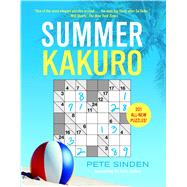
What is included with this book?
The New copy of this book will include any supplemental materials advertised. Please check the title of the book to determine if it should include any access cards, study guides, lab manuals, CDs, etc.
The Used, Rental and eBook copies of this book are not guaranteed to include any supplemental materials. Typically, only the book itself is included. This is true even if the title states it includes any access cards, study guides, lab manuals, CDs, etc.
INTRODUCTION
What is Kakuro?
Kakuro is an extremely addictive puzzle game -- a test of skill and logic. All
you have to do is place numbers 1 to 9 on the puzzle grid. Easy!
Or is it? Only one arrangement of numbers will give the correct answer. It can
be seductively simple or it can be mind-bending. This book contains 201 Kakuro
puzzles at four levels of difficulty (Piece of Cake, Tea Break, Lunch Break and
All Nighter) -- enough to satisfy beginners and addicts alike for hours on end.
How to play Kakuro
The diagram overleaf shows a small Kakuro puzzle. The objective is to place
numbers 1 to 9 in the white cells on the grid, so that each row or column of
adjoining white cells adds up to the total printed in the dark grey cell to
their left (for a row) or above (for a column). The light grey cells do not play
any part in the game.
YOU MUST place the numbers 1 to 9 in the white cells in the unique arrangement
so that all the column and row totals are correct.
YOU MUST NOT repeat a number in any continuous row or column of white cells.
How to crack Kakuro
Begin by looking at the totals (the dark grey cells) -- these are your first
clues.
For example:
Looking at the puzzle shown, and starting in its simplest area, the bottom row,
there are two white cells that must add together to make 3 (the value marked in
the dark grey cell to their left).
We know that 1 + 2 = 3. Any other combination of two numbers between 1 and 9,
where no number is repeated, will add up to a value greater than 3, so this row
must contain 1 and 2.
All we have to do now is determine the order in which they should appear: is it
[1,2] or [2,1]? To do this we must look at the neighbouring cells.
Look first at the two cells in the row above. We are told these contain two
numbers that add to make 4. 1 + 3 is the only combination of two numbers that
add to make 4, without repeating a number (2 + 2 would repeat the value 2).
Look next at the far right column of the grid. It contains two numbers that add
to make 3, so we know it must contain a 1 and a 2 (using the same reasoning that
we used for the bottom row).
So which number goes in which cell?
Let's try a few combinations and see how we get on. First we will try placing
the numbers 1 and 2 in the bottom row in the order [2,1].
If we do this we must place a 2 in the last cell of the row above, to make the
far right column add up to 3. However, as this cell's row must be made up of a 1
and a 3, to give a total of 4, placing a 2 must be wrong.
Therefore we must go back and try placing the numbers in the bottom row in a
different order [1,2], and then follow the same logical steps to see if this
results in a better outcome.
As we can see, all the numbers we have placed now add up to the correct column
and row totals without repeating any value in any row or column. In fact, they
also allow us to make the leap quickly to filling in a 2 in the only open white
cell in the fourth column, to give the required column total of 6.
In larger puzzles, several continuous blocks of white cells may appear in a
single row (as in a crossword). While you must not repeat a value in any
adjoining white cells, you may repeat values across the whole row or column
providing they fall in separate groups of white cells. The example below should
explain this clearly:
As can be seen, the numbers 1 and 3 appear twice in the top row. This is
perfectly correct as they do not appear more than once in either of the two
ontinuous blocks of adjoining white cells.
Conclusion
When you first see a Kakuro puzzle, you may think it is all about maths. Don't
be fooled. And don't panic. It isn't. Only simple sums are ever used and these
are repeated time and again, so quickly become second nature.
But for anyone who wasn't paying attention (or prefers never to add), cheat
sheets are included at the back of this book listing by total all the possible
valid number combinations from 1 to 9.
Arranging the numbers is the challenge!
Then starts the addiction...
Kakuro will drive you crazy.
The greatest challenge will be putting it down...
Text copyright © 2005 by Peter Sinden
Excerpted from Summer Kakuro by Pete Sinden
All rights reserved by the original copyright owners. Excerpts are provided for display purposes only and may not be reproduced, reprinted or distributed without the written permission of the publisher.